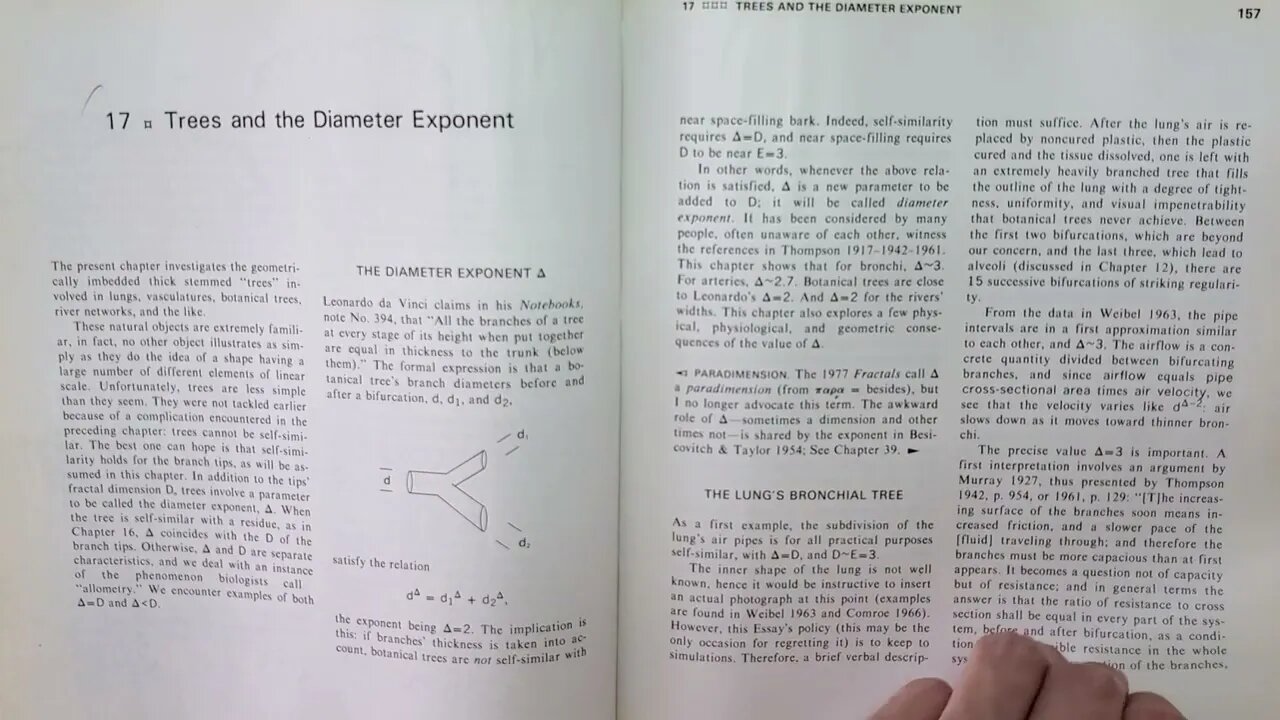Premium Only Content

Fractal Geometry of Nature 023 by Benoit B Mandelbrot 1977 Amateur Audio Book Reading Session 023
Fractal Geometry of Nature 023 by Benoit B Mandelbrot 1977 Amateur Audio Book Reading Session 023
June 27 2022 Cold Unrehearsed Reading
Amateur Audio Book Reading
Highly technical book and I'm pronouncing many greek letters/ words incorrectly
WARNING - I AM NOT A FRACTAL EXPERT. I AM READING & LEARNING AND WILL PRONOUNCE MANY WORDS INCORRECTLY. THIS IS A DIFFICULT READ. MANY UNFAMILIAR MATH, SYMBOLS, GREEK, ETC. I AM READING THIS BOOK AS THOUGH I AM READING TO MYSELF.
468 Pages
Published 1977, 1982, 1983
WH Freeman and Company New York
International Business Machines Thomas J Watson Research Center
Clouds are not spheres, mountains are not cones, and lightening does not travel in a straight line. The complexity of nature's shapes differs in kind, not merely degree, from that of the shapes of ordinary geometry, the geometry of fractal shapes.
Now that the field has expanded greatly with many active researchers, Mandelbrot presents the definitive overview of the origins of his ideas and their new applications. The Fractal Geometry of Nature is based on his highly acclaimed earlier work, but has much broader and deeper coverage and more extensive illustrations.
Benoit B. Mandelbrot (20 November 1924 – 14 October 2010) was a Polish-born French-American mathematician and polymath with broad interests in the practical sciences, especially regarding what he labeled as "the art of roughness" of physical phenomena and "the uncontrolled element in life". He referred to himself as a "fractalist" and is recognized for his contribution to the field of fractal geometry, which included coining the word "fractal", as well as developing a theory of "roughness and self-similarity" in nature.
In 1936, at the age of 11, Mandelbrot emigrated with his family to France from Warsaw, Poland. After World War II ended, Mandelbrot studied mathematics, graduating from universities in Paris and in the United States and receiving a master's degree in aeronautics from the California Institute of Technology. He spent most of his career in both the United States and France, having dual French and American citizenship. In 1958, he began a 35-year career at IBM, where he became an IBM Fellow, and periodically took leaves of absence to teach at Harvard University. At Harvard, following the publication of his study of U.S. commodity markets in relation to cotton futures, he taught economics and applied sciences.
Because of his access to IBM's computers, Mandelbrot was one of the first to use computer graphics to create and display fractal geometric images, leading to his discovery of the Mandelbrot set in 1980. He showed how visual complexity can be created from simple rules. He said that things typically considered to be "rough", a "mess", or "chaotic", such as clouds or shorelines, actually had a "degree of order". His math and geometry-centered research career included contributions to such fields as statistical physics, meteorology, hydrology, geomorphology, anatomy, taxonomy, neurology, linguistics, information technology, computer graphics, economics, geology, medicine, physical cosmology, engineering, chaos theory, econophysics, metallurgy, and the social sciences.
#audiobook #videobook #education
-
 21:00
21:00
Analog Video Books - Read with Me
2 months agoHow Not To Invest 004 Barry Ritholtz 2025 Audio/Video Book S004
35 -
 9:36
9:36
Silver Dragons
1 hour agoGold Price NEW ALL TIME HIGH - $5,000 GOLD NEXT?
44 -
 LIVE
LIVE
LFA TV
10 hours agoLFA TV ALL DAY STREAM - FRIDAY 9/5/25
1,077 watching -
 13:43
13:43
The Kevin Trudeau Show Limitless
2 days agoClassified File 3 | Kevin Trudeau EXPOSES Secret Society Brainwave Training
86.8K16 -
 1:11:24
1:11:24
vivafrei
5 hours agoDearborn Heights Police Have Been CONQUERED! Gender Madness on PASSPORTS! Canada Stuff & MORE!
84.2K34 -
 1:44:43
1:44:43
The Quartering
4 hours agoConservative Scam Busted, Black Fatigue Hits Airlines, Kimmel Meltdown
96.5K36 -
 39:07
39:07
Tudor Dixon
1 hour agoRFK Jr., Big Pharma, and the Hidden Risks of SSRIs in Pregnancy | The Tudor Dixon Podcast
4.51K -
![MAHA News [9.5] RFK Lights Up Congress, CDC House Cleaning, Fight Over Vax Mandates For School Children](https://1a-1791.com/video/fww1/b9/s8/1/i/h/m/f/ihmfz.0kob-small-MAHA-News-9.5.jpg) LIVE
LIVE
Badlands Media
13 hours agoMAHA News [9.5] RFK Lights Up Congress, CDC House Cleaning, Fight Over Vax Mandates For School Children
474 watching -
 59:29
59:29
The Tom Renz Show
2 hours agoWho Is Undermining Trump?
3.33K3 -
 1:00:55
1:00:55
Mark Kaye
5 hours ago🔴 Trump Tells Tech Tycoons It's Time To Pay Up!
19.7K5